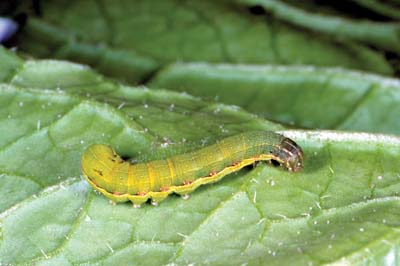
Beet armyworm, Spodoptera exigua, larva.
(Photographer: L. Buss, University of Florida)
The beet armyworm has a wide host range in vegetable crops that includes asparagus, bean, beet, broccoli, cabbage, cauliflower, celery, chickpea, corn, cowpea, eggplant, lettuce, onion, pea, pepper, potato, radish, spinach, tomato, and turnip. The larvae feeding on foliage and fruit cause damage. When sampling for beet armyworm, pheromone traps may be used as well as visual sampling. Crops should be monitored at least twice a week. Insecticides are commonly used to control beet armyworm, but resistance is a major problem in the management of this insect. Beet armyworms can be also be controlled with neem products, insect growth regulators, and Bacillus thuringiensis. Chemical control is more effective when early instars are targeted.
Images
To save the Web-optimized images shown below to your hard drive:
|
Click to access Display and Print quality images. |
|
Click to access Display and Print quality images. |
|
Click to access Display and Print quality images. |
|
Click to access Display and Print quality images. |
|
Click to access Display and Print quality images. |
|
Click to access Display and Print quality images. |
|
Click to access Display and Print quality images. |